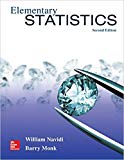
Concept explainers
Genetics: Pea plants contain two genes for seed color, each of which may be Y (for yellow seeds) or G (for green seeds). Plants that contain one of each type of gene are called heterozygous. According to the Mendelian theory of genetics, if two heterozygous plants are crossed, each of their offspring will have
- Approximate the probability that more than 30 have green seeds.
- Approximate the probability that 80 or fewer have yellow seeds.
- Approximate the probability that the number with green seeds is between 30 and 35, inclusive.
a.
The approximated probability that more than
Answer to Problem 22E
The approximated probability that more than
Explanation of Solution
Given Information:
According to the Mendelian theory of genetics, if two heterozygous plants are crossed, each of their offspring will have probability
Formula used:
Calculation:
The sample size issize is
Since,
And
This means normal approximation can be used.
The standard deviation is,
Since the probability is
Calculating the
The required probability is,
Hence, the approximated probability that more than
b.
The approximated probability that
Answer to Problem 22E
The approximated probability that
Explanation of Solution
Given Information:
The sample size is
Calculation:
The sample size issize is
Since,
And
This means normal approximation can be used.
The standard deviation is,
Since the probability is
Calculating the
The required probability is,
Hence, the approximated probability that
c.
The approximated probability that the number with green seeds is between
Answer to Problem 22E
The approximated probability that the number with green seeds is between
Explanation of Solution
Given Information:
The sample size is
Calculation:
Since, the probability is
Calculating the
Calculating the
The required probability is
Hence, the approximated probability that the number with green seeds is between
Want to see more full solutions like this?
Chapter 7 Solutions
Elementary Statistics 2nd Edition
- A company found that the daily sales revenue of its flagship product follows a normal distribution with a mean of $4500 and a standard deviation of $450. The company defines a "high-sales day" that is, any day with sales exceeding $4800. please provide a step by step on how to get the answers in excel Q: What percentage of days can the company expect to have "high-sales days" or sales greater than $4800? Q: What is the sales revenue threshold for the bottom 10% of days? (please note that 10% refers to the probability/area under bell curve towards the lower tail of bell curve) Provide answers in the yellow cellsarrow_forwardFind the critical value for a left-tailed test using the F distribution with a 0.025, degrees of freedom in the numerator=12, and degrees of freedom in the denominator = 50. A portion of the table of critical values of the F-distribution is provided. Click the icon to view the partial table of critical values of the F-distribution. What is the critical value? (Round to two decimal places as needed.)arrow_forwardA retail store manager claims that the average daily sales of the store are $1,500. You aim to test whether the actual average daily sales differ significantly from this claimed value. You can provide your answer by inserting a text box and the answer must include: Null hypothesis, Alternative hypothesis, Show answer (output table/summary table), and Conclusion based on the P value. Showing the calculation is a must. If calculation is missing,so please provide a step by step on the answers Numerical answers in the yellow cellsarrow_forward
 Holt Mcdougal Larson Pre-algebra: Student Edition...AlgebraISBN:9780547587776Author:HOLT MCDOUGALPublisher:HOLT MCDOUGAL
Holt Mcdougal Larson Pre-algebra: Student Edition...AlgebraISBN:9780547587776Author:HOLT MCDOUGALPublisher:HOLT MCDOUGAL Algebra & Trigonometry with Analytic GeometryAlgebraISBN:9781133382119Author:SwokowskiPublisher:Cengage
Algebra & Trigonometry with Analytic GeometryAlgebraISBN:9781133382119Author:SwokowskiPublisher:Cengage College Algebra (MindTap Course List)AlgebraISBN:9781305652231Author:R. David Gustafson, Jeff HughesPublisher:Cengage Learning
College Algebra (MindTap Course List)AlgebraISBN:9781305652231Author:R. David Gustafson, Jeff HughesPublisher:Cengage Learning Elementary Linear Algebra (MindTap Course List)AlgebraISBN:9781305658004Author:Ron LarsonPublisher:Cengage Learning
Elementary Linear Algebra (MindTap Course List)AlgebraISBN:9781305658004Author:Ron LarsonPublisher:Cengage Learning College AlgebraAlgebraISBN:9781305115545Author:James Stewart, Lothar Redlin, Saleem WatsonPublisher:Cengage Learning
College AlgebraAlgebraISBN:9781305115545Author:James Stewart, Lothar Redlin, Saleem WatsonPublisher:Cengage Learning





